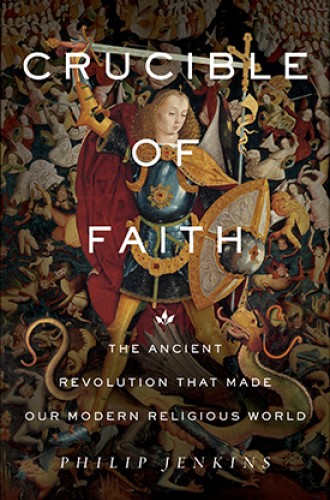What’s behind the New Testament?
There is abundant documentation of the intertestamental period. We just haven't read it.
When I took my first New Testament course at Fuller Theological Seminary, the professor, Robert Guelich, opened the first class by asking who, after Jesus and Paul, was most responsible for the spread of Christianity. Eager students raised their hands and offered various answers: Peter, Mary, Augustine.
“No,” Professor Guelich countered, “It was Alexander the Great.” He went on to explain how the young conqueror, dead for three centuries by the time Jesus was born, had laid the roads upon which the Roman Empire was built, and over which the gospel was subsequently spread. “Without Alexander the Great,” he told us, “no missionary journeys for Paul, and no Christianity.”
Read our latest issue or browse back issues.
If Alexandrian roads provide a geographical map for the promulgation of Christianity, Philip Jenkins has provided us with a political-spiritual-textual map in his outstanding new book. Jenkins, a trusted historian and observer of the ebbs and flows of Christendom, has set his sights on a little-known period, which he dubs the “Crucible Era,” 250–50 BCE. It was in these two centuries, he argues, that the table was set for the emergence of Christianity and Rabbinic Judaism. (He says it paved the way for Islam, too, but here I think he’s stretching his thesis a bit.)
Many of us refer to these years as the intertestamental period, and they mostly remain shrouded in mystery to clergy and laity alike. Between the Lord’s closing words in Malachi and the genealogy of Matthew, all we know is that there are some apocryphal books that Catholics have in their Bibles but seldom read. Maybe there was a Jewish revolt in there at some point. And weren’t the Dead Sea Scrolls from that time?
As it turns out, there is abundant textual documentation of these years—we’ve just not read it. Jenkins has, and it’s astounding. As he goes through the evidence, the catalogue grows. Just about everything we consider central to New Testament Christianity got its start in the crucible era: apocalypse, heaven and hell, angels and demons, synagogues, and prayer, to name just a few.
Jenkins reveals that this was an incredibly violent time. Jewish-on-Jewish warfare was common, and among the myths that Jenkins debunks is that the Romans were bad and the Jews were good; as usual, history is more complex than that. Instead, there was a violent fight for the soul of Judaism led by new religio-political parties: Sadducees, Pharisees, and Essenes. And here’s another busted myth: by Jesus’ time “it was the Pharisees who were the modernizers, who had absorbed all the innovations of the previous two centuries. . . . The Sadducees, by contrast, were conservatives who refused to accept those theological changes.”
The innovations that the Pharisees embraced came in large part from the book of 1 Enoch, which has been largely forgotten (except by the Ethiopian Orthodox Church, which considers it canonical). Jenkins tells us that Enoch wasn’t an evolution in religious thought. Rather, it “represented a breathtaking departure from the Old Testament worldview.” The book, which Jenkins dates between 250 and 100 BCE, reflects the incredible tumult within Hebrew religion as it came into contact with Greek philosophy from without and the aforementioned parties vying for power within.
Jenkins writes that “1 Enoch pioneers new visions of the apocalyptic,” and it contains the “first draft of Hell.” Today’s conservative evangelicals who claim that unrepentant sinners will suffer “eternal, conscious torment” can thank the author of Enoch, Jenkins tells us. An entirely new spiritual universe was invented, one that included Satan, spiritual forces, and good and evil in pitched battle. It was onto this stage that an apocalyptic rabbi, Jesus of Nazareth, would step a century later.
In addition to the spiritual revolution of the crucible era, Jenkins details the political tumult of that time. He deftly untangles a knot of names—Seleucus, Antiochus (I–VII), Ptolemy (I–VIII), John Hyrcanus, Aristoboulus—and argues that the kingdom of Israel that Jesus and his followers longed to restore was actually the Hasmonaean state, which had fallen in the mid-first century BCE. But the Hasmonaeans were no conservatives, either. They adopted Greek names and dress, and they departed from the traditional Hebrew concepts of monarchy. They also reigned over a period of relative stability; after them came the Herodians and then the Romans.
Palestine, Jenkins writes, “never knew anything vaguely like good government. . . . Given the long history of political disasters and the sectarian response, it is not difficult to appreciate the very negative perception of worldly governments in the New Testament or the desperate hope for divine rule that might offer justice.”
Enter Jesus.
It could be argued that New Testament Christianity is based more on what happened during the crucible era than on anything we read about in the Hebrew Bible. If this is a shocking statement, it also emphasizes the importance of this book. I’ve been studying Jesus, the Bible, Christian origins, and ancient history for a long time, and never has a book cracked open so many mysteries as this one. Jenkins shines a light on the crucible years in a readable and engaging book that, without hyperbole, I can say every Christian should read. After reading Crucible of Faith, you will be a better reader of the New Testament.







